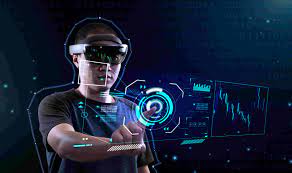Discussing the Virtual reality and Augmented reality
The Virtual Reality and Augmented Reality is boundless, and we have only scratched the surface these technologies can achieve.

In the realm of technology, few innovations have garnered as much excitement and potential as virtual reality (VR) and augmented reality (AR).
These immersive technologies have rapidly evolved and are finding applications in a multitude of industries, from gaming and entertainment to healthcare and education.
In this blog post, we will explore the limitless possibilities that VR and AR offer across various domains.
The Rise of Virtual reality and Augmented reality
Virtual reality, often abbreviated as VR, is a technology that transports users to a completely digital environment.
By wearing a VR headset, users can immerse themselves in a computer-generated world that can be entirely fictional or a realistic simulation of the real world. Here are some of the promising applications of VR:
- Gaming and Entertainment: VR gaming has taken the gaming industry by storm. With immersive experiences and interactive gameplay, VR games offer a level of engagement that traditional gaming cannot match. Players can explore fantastical worlds, solve puzzles, and even simulate physical activities like boxing or golfing. Additionally, VR has brought a new dimension to the entertainment industry, enabling users to attend virtual concerts, explore virtual art galleries, and even watch movies in a virtual cinema.
- Training and Simulation: VR is revolutionizing training across various sectors. In fields like aviation and medicine, trainees can practice complex procedures in a safe and controlled virtual environment, reducing the risk associated with real-world training. Military personnel use VR for combat simulations, while firefighters can train for emergency situations. This technology has immense potential for enhancing the skills of professionals across multiple domains.
- Education: Virtual reality has the power to transform the way we learn. In education, students can take virtual field trips to historical sites, explore the inner workings of the human body, or engage in chemistry experiments without the need for physical equipment. VR also helps educators create engaging and interactive learning experiences, making complex subjects more accessible and enjoyable for students.
- Healthcare: The healthcare industry is leveraging VR for a range of applications. Surgeons can practice complex surgeries in a risk-free environment, leading to improved patient outcomes. VR is also used for pain management, physical therapy, and treating conditions like PTSD and anxiety. Patients can escape the confines of their hospital rooms and experience therapeutic environments that aid in their recovery.
Unlocking the Potential of Virtual reality and Augmented reality
Augmented reality, or AR, is a technology that overlays digital information on the real world. Unlike VR, AR does not replace the physical environment but enhances it by adding digital elements. Here are some of the ways AR is making an impact:
- Gaming: The most famous example of AR gaming is Pok?mon GO, which took the world by storm. By blending the real world with virtual creatures, players were encouraged to explore their surroundings in search of Pok?mon. AR gaming opens up new possibilities for interactive and location-based experiences that encourage physical activity and social interaction.
- Navigation: AR has the potential to revolutionize how we navigate and interact with our surroundings. AR navigation apps can provide real-time directions and information about nearby points of interest by simply pointing your smartphone or AR glasses at your surroundings. This technology can enhance travel experiences, making it easier for users to explore unfamiliar places.
- Retail and Shopping: AR is changing the way we shop. Retailers are using AR to offer customers immersive shopping experiences. With AR, shoppers can try on clothes virtually, visualize furniture in their homes before purchasing, and even see how makeup products would look on their skin. This not only enhances the shopping experience but also reduces the likelihood of returns.
- Industrial and Manufacturing: AR is becoming an indispensable tool in the industrial sector. Workers can use AR glasses to receive real-time instructions, schematics, and data while they perform tasks. This improves efficiency, reduces errors, and enhances safety. Maintenance and repair processes in industries like aviation and manufacturing are benefiting greatly from AR technology.
Converging Virtual reality and Augmented Realities: Mixed Reality
As technology advances, the lines between VR and AR are blurring, giving rise to a concept known as mixed reality (MR). MR combines elements of both VR and AR to create environments where physical and digital objects coexist and interact seamlessly. This convergence is opening up exciting possibilities:
- Design and Engineering: Architects and engineers can use MR to create 3D prototypes that can be manipulated in real-time. This enables collaborative design processes and better visualization of projects before they are constructed.
- Collaboration: In the era of remote work, MR is reshaping how teams collaborate. Colleagues from different parts of the world can meet in a virtual boardroom, interact with digital documents, and work on projects together as if they were in the same physical space.
- Retail and Marketing: MR is changing the way businesses engage with customers. Imagine trying on a pair of shoes in a virtual store while seeing yourself in a mirror, with digital information about the product appearing alongside. This kind of immersive shopping experience is on the horizon.
Challenges and Considerations
While the potential of VR and AR is immense, there are challenges that must be addressed for widespread adoption and success:
- Cost: High-quality VR and AR devices can be expensive, limiting access for some individuals and organizations. As technology advances, we can expect prices to decrease, but affordability remains a concern.
- Content Creation: Creating compelling VR and AR content requires specialized skills and tools. The industry needs more content creators and accessible development platforms to drive innovation.
- Privacy and Ethical Concerns: As these technologies become more integrated into our lives, questions of privacy, data security, and ethical use must be addressed. Balancing innovation with responsible implementation is crucial.
- Health and Safety: Prolonged use of VR can lead to discomfort or motion sickness for some users. Addressing these physical and psychological concerns is important for the long-term success of VR and AR.
The Future of VR and AR
The journey of virtual reality and augmented reality is just beginning. As technology continues to evolve, we can expect to see these immersive technologies play an even more significant role in our lives. Here are some exciting possibilities for the future:
- Healthcare Revolution: VR and AR will continue to transform healthcare, enabling remote consultations, personalized treatments, and advanced simulations for medical training.
- Education Transformation: VR and AR will redefine education, making learning more interactive, engaging, and accessible to learners of all ages and backgrounds.
- Workplace of Tomorrow: Virtual offices and remote collaboration tools will become more sophisticated, changing the way we work and connect with colleagues worldwide.
- Entertainment Evolution: The entertainment industry will push the boundaries of storytelling and gaming, offering immersive experiences that blur the lines between fiction and reality.
- Economic Impact: The VR and AR market is poised for significant growth, creating job opportunities and economic benefits across various sectors.
In conclusion, virtual reality and augmented reality are not merely technologies of the future; they are transformative forces reshaping how we live, work, learn, and play. Their potential to revolutionize industries and enhance our daily experiences is boundless.
As these technologies become more accessible, it's crucial for individuals, organizations, and policymakers to harness their power responsibly and ethically, ensuring a future where VR and AR enrich our lives and drive positive change.
What's Your Reaction?

















